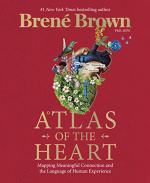|
This section contains 649 words (approx. 2 pages at 400 words per page) |

|
Atlas of the Heart Summary & Study Guide Description
Atlas of the Heart Summary & Study Guide includes comprehensive information and analysis to help you understand the book. This study guide contains the following sections:
This detailed literature summary also contains Topics for Discussion on Atlas of the Heart by Brené Brown.
A dictionary of the language of human emotion and experience, Atlas of the Heart is broken into 13 chapters, all of which have the phrase “Places We Go” in the title. Each chapter covers between three and eight emotions, incorporating information and conclusions from a variety of researchers as well as anecdotes from the life of Brene Brown. As the definitions of each emotion are somewhat lengthy and complicated, the summary below will only provide lists of the emotions covered in each chapter.
In the first chapter, “Places We Go When Things Are Uncertain or Too Much,” Brene Brown defines the emotions of stress, overwhelm, anxiety, worry, avoidance, excitement, dread, fear, and vulnerability. In this chapter Brown describes her personal experiences with these emotions, starting with a narration of her experience of being a waitress in a busy restaurant, where she discovered coping skills that she still uses to this day. In the second chapter “Places We Go When We Compare,” the author provides instruction on comparison, admiration, reverence, envy, jealousy, resentment, schadenfreude, and freudenfreude. These emotions all relate to our relationships with those around us, and several of them are connected to a social group’s collective emotion.
“Places We Go When Things Don’t Go as Planned,” is the title of chapter three. In this chapter, author describes boredom, disappointment, expectations, regret, discouragement, resignation, and frustration. Brown comments how, although all of these emotions would be considered negative states, they all are necessary for survival. In chapter four, “Places We Go When It’s Beyond Us,” the author defines awe, wonder, confusion, curiosity, interest, and surprise. These emotions, Brown notes, are related to learning and knowledge-building.
The fifth chapter, “Places We Go When Things Aren’t What They Seem,” Brown provides instruction on amusement, bittersweetness, nostalgia, cognitive dissonance, paradox, irony, and sarcasm. What these emotions have in common is their duality. In chapter six, “Places We Go When We’re Hurting,” Brown describes anguish, hopelessness, despair, sadness, and grief. The emotional weight of this chapter is relieved by vivid text features and photographs.
“Places We Go With Others” is the title of chapter seven. Here, Brown defines compassion, pity, empathy, sympathy, boundaries, and comparative suffering, all emotions which will connect to Brown’s overarching theme of making meaningful connections. In “Places We Go When We Fall Short, Brown defines shame, self-compassion, perfectionism, guilt, humiliation, and embarrassment. Portions of this chapter connect to the societal impact of these emotions.
In chapter nine, “Places We Go When We Search for Connection,” Brown provides instruction on belonging, fitting, in, connection, disconnection, insecurity, invisibility, and loneliness. This chapter provides valuable information on the important of an individual belonging to a community. “Places We Go When the Heart Is Open,” is chapter ten. Here, Brown describes love, lovelessness, heartbreak, trust, self-trust, betrayal, defensiveness, flooding, and hurt. Much of this chapter describes how to implement cognitive methods to escaping these negative states.
A direct contrast to chapter ten, chapter eleven, “Places We Go When Life Is Good,” is about joy, happiness, calm, contentment, gratitude, foreboding joy, relief, and tranquility. Brown’s explanation on the benefits of gratitude is the focal point of this chapter. The title of Chapter twelve is “Places We Go When We Feel Wronged.” Here, Brown describes anger, self-righteousness, contempt, disgust, dehumanization, and hate.” There is ample commentary in this chapter connecting these emotions to the social divisions that exist in the present day.
Chapter thirteen, “Places We Go to Self-Assess,” is devoted to the description of pride, hubris, and humility. These three emotions also connect to events happening at the time of the writing of the book. The final section, which is presented as an afterward, describes how to cultivate meaningful connection through concrete steps, and is illustrated in a comic that demonstrates the do’s and don’ts of a skill Brown considers inextricably linked to wellness.
Read more from the Study Guide
|
This section contains 649 words (approx. 2 pages at 400 words per page) |

|



